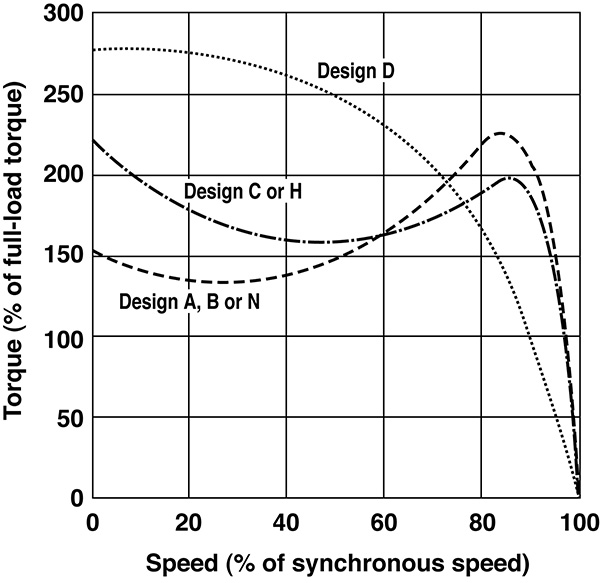The nameplates of alternating current (AC) motors built to National Electrical Manufacturers Association (NEMA) standards reference a system of alphabetical letters that designate the principal characteristics of each motor—code, design and insulation class. Though critical to proper motor selection, these designations are easy to misinterpret.
The letter B, for instance, might represent the design code, insulation class or kilovolt amperes (kVA) code (though highly unlikely). Therefore, understanding what the different designations mean and reconfirming their appropriateness for all replacement motor applications is important.
Code
For motors less than ½ horsepower, the code letter on the nameplate represents the locked-rotor kVA. On larger motors, it identifies the locked-rotor kVA per horsepower. NEMA Stds. MG 1, 10.37.2, defines the latter codes using a series of letters from A to V.
Generally, the farther a code letter is from A, the higher the inrush current per horsepower. This is important because a replacement motor with a higher code letter may require different upstream electrical equipment—such as a larger motor starter.
Note: Similar letters are used on the nameplate to designate other motor characteristics (for example, design and insulation class). Read the nameplate carefully to avoid misinterpretations.
Design
Based on torque and current characteristics, NEMA Stds. MG 1, 1.18, defines four motor design classifications: A, B, C and D (see Table 1). Common headings that precede the design letter on motor nameplates include Des, NEMA Design and Design.
 |
| Table 1. Characteristics of NEMA design motors |
Most motors, such as centrifugal pump motors, fall into the Design B category, which is characterized by comparatively high energy efficiency and torque ratings.
Although Design A is best from an efficiency standpoint, these motors are used sparingly because their relatively high starting currents can cause nuisance tripping of motor protection circuitry. Design A motors may also require larger-than-standard starters.
Some motors may not conform to any of the torque-current characteristics defined in NEMA Stds. MG 1. In such cases, the motor manufacturer may assign a letter that is not an industry-defined standard or simply not list a design letter on the nameplate.
When replacing a motor, always check for the design letter and determine if the same design is still appropriate for the application. Consider all changes that may have occurred since the original motor’s installation.
One of the more common misapplications is the attempt to replace a Design C or D motor with a Design B. The unfortunate outcome is usually that the Design B motor, with its lower starting torque (see Figure 1), cannot accelerate the load to operating speed. Although Design B is applicable to the vast majority of pumps, positive displacement pumps that start with a load require a design C motor, and oilfield pump motors with flywheels need design D motors.
 |
| Figure 1. Speed-torque curives for NEMA design motors |
Insulation Class
Often abbreviated “Ins. Cl.” on nameplates, insulation class is a standard, industry classification of the thermal endurance of the motor winding. Insulation class is indicated by a letter designation such as A, B, F or H (see Table 2), depending on the winding’s ability to withstand a given operating temperature for a given life. Insulation classes with a letter deeper into the alphabet perform better.
 |
| Table 2. Temperature classification of insulation systems |
For example, Class F insulation has a longer nominal life at a given operating temperature than Class A, or for a given life, it can survive higher temperatures.
Manufacturers produce some motors using a higher insulation class than indicated on the nameplate. A motor wound using Class F insulation, for instance, may be listed for a Class B rise.
The reason for doing so is to provide a more thermally robust winding capable of better handling real-world operating conditions. For similar reasons, many Electrical Apparatus Service Association (EASA) service centers upgrade winding insulation to Class H.
Operating temperature is a result of ambient conditions plus the energy lost in the form of heat (causing temperature rise) as the motor converts electrical energy to mechanical work.
The ultimate temperature in the winding is the sum of the ambient and the winding temperature rise.
For example, if a motor is rated with a 1.15 service factor and has a class B (130 C) insulation system, the temperature rise according to NEMA Stds. MG 1 is 90 C, and the maximum ambient temperature limit is 40 C. The winding’s total temperature would be 90 C + 40 C, or 130 C.
Operating at above-rated temperatures will shorten the life of the winding, generally reducing it by half for every 10 C increase. P&S

